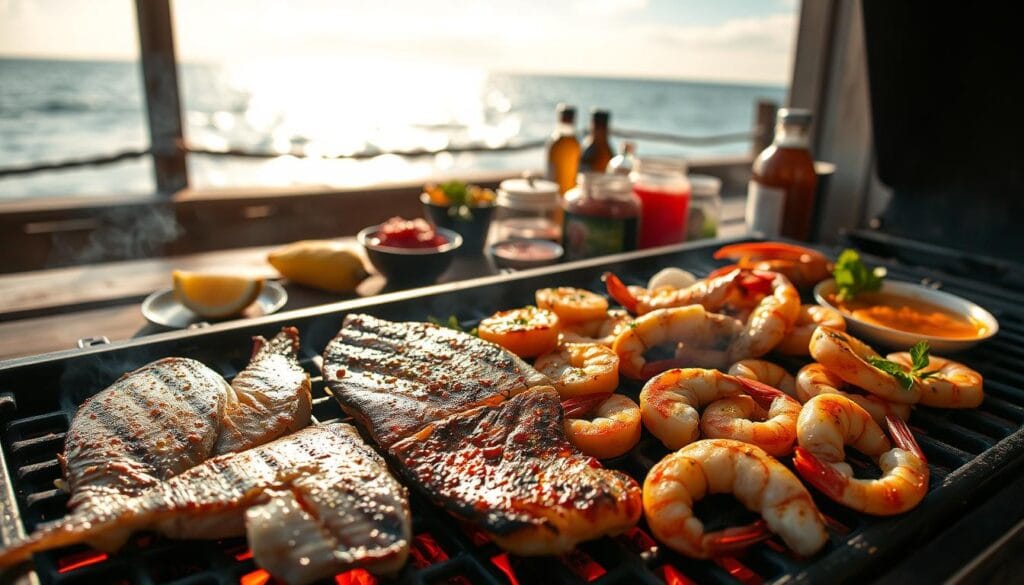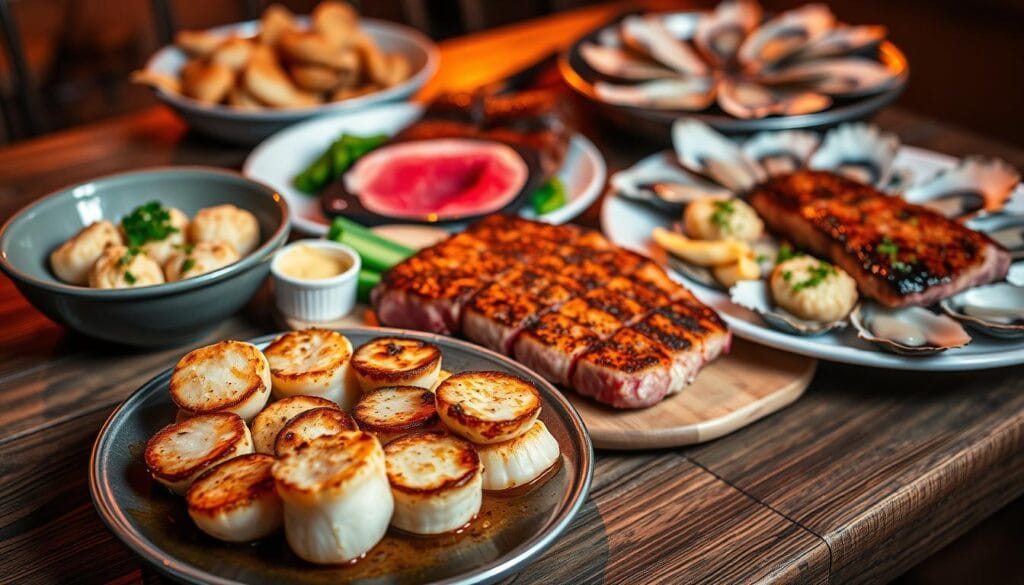The salty breeze of the East Coast whispers stories of maritime tradition. Growing up near the Chesapeake Bay, I learned early that east coast seafood is more than just a meal. It’s a cultural experience that connects generations through flavor and technique.
The Mid Atlantic seafood scene offers an incredible array of oceanic treasures waiting to be discovered. From blue crabs dancing in Maryland waters to the diverse fish species populating coastal ecosystems, this region represents a culinary playground for seafood enthusiasts.
Your journey into Mid Atlantic seafood begins with understanding the rich marine landscape that defines our eastern seaboard. Each catch tells a story of sustainable fishing, generational knowledge, and culinary artistry. This transforms simple ingredients into extraordinary dishes.
Table of Contents
Understanding Mid Atlantic Seafood Varieties
The Chesapeake Bay and its coastal areas are a treasure trove of seafood. They delight both food lovers and those looking for healthy options. Maryland and Virginia seafood come from a rich marine world, full of diverse and tasty sea creatures.
Chesapeake Bay seafood is known for its high quality and special flavors. The area’s waters are home to many seafood species. These are not only good for you but also taste amazing.
Popular Seafood Species
The Mid Atlantic is famous for several seafood types:
- Blue Crabs: Maryland’s star seafood, available from April to November
- Rockfish (Striped Bass)
- Oysters
- Clams
- Scallops
Seasonal Availability and Freshness
Knowing when seafood is in season is key to getting the best. Each type of seafood has its peak time, ensuring the best taste and quality.
| Seafood Species | Peak Season |
|---|---|
| Blue Crabs | April – November |
| Oysters | September – April |
| Rockfish | Spring and Fall |
Health Benefits
Mid Atlantic seafood is a nutritional powerhouse. It’s full of:
- High-quality protein
- Omega-3 fatty acids
- Essential minerals
- Low-calorie protein source
By picking local seafood from Maryland and Virginia, you’re not just eating well. You’re also helping the local fishing industry and supporting the local economy.
Selecting Fresh Seafood
Choosing the right seafood is key to making tasty meals that show off Mid Atlantic cuisine. Knowing how to pick fresh, quality seafood can make your cooking and eating better.
Signs of Freshness to Look For
When picking seafood, watch for these signs of quality:
- Blue crabs should be alive and active with bright, clean shells
- Rockfish should have clear, bright eyes and firm flesh
- Oysters must have tightly closed shells or snap shut when tapped
Seafood spoils fast, so knowing how fresh it is is very important. The best storage is near 32°F. Use fresh fish within 2 days of buying it.
Ethical Sourcing and Sustainability
Your seafood choices affect taste and the planet. Look for signs of responsible fishing:
- Marine Stewardship Council (MSC) certification
- Seafood Watch recommendations
- Local fishery sustainable labels
Where to Buy Quality Seafood
For the best seafood, know where to go. Here are places to buy blue crabs, rockfish, and oysters:
- Local fish markets with daily fresh catches
- Reputable online seafood suppliers
- Direct-from-fishermen markets
- Specialty seafood stores with strict quality control
Pro tip: Always ask your fishmonger about the catch date and origin of the seafood to ensure maximum freshness.
Preparing Seafood for Cooking
Getting your seafood ready is key to making tasty meals from Mid Atlantic catches. Whether it’s clams, scallops, or other local seafood, knowing the right methods boosts your cooking. It also ensures the best taste and texture.
Essential Tools and Equipment
To work with seafood well, you’ll need a few important tools:
- Sharp filleting knife
- Seafood shears
- Cutting board
- Kitchen towels
- Large bowl for cleaning
Cleaning and Filleting Techniques
Here’s how to prepare clams and scallops:
- Rinse seafood under cold water
- Look for any damaged shells or debris
- Remove beard from scallops carefully
- Pat dry with paper towels
Proper Storage Methods
Storing fresh seafood right is important. For live crabs, keep them in a cooler with ice or frozen packs. Cover them with damp newspapers and leave the lid a bit open for air.
Refrigerate clams and scallops at 40°F or below. Use a sealed container with ice.
Pro tip: Buy seafood on the day you plan to cook it. This ensures it’s fresh and tastes great.
Cooking Techniques for Mid Atlantic Seafood
Learning to cook mid Atlantic seafood can make it truly special. The east coast seafood has many flavors that shine with different cooking methods. Here’s how to cook your seafood to perfection.
Grilling Fresh Seafood
Grilling brings out the natural flavors of mid Atlantic seafood. To grill fish or shellfish well, remember these tips:
- Preheat grill to medium-high heat (375-400°F)
- Use a seafood grilling basket to prevent sticking
- Brush seafood with olive oil to enhance moisture
- Cook most fish fillets for 3-4 minutes per side

Steaming and Boiling Techniques
Steaming and boiling are great for crustaceans from the east coast. Each method has its own benefits:
| Cooking Method | Best For | Cooking Time |
|---|---|---|
| Steaming | Blue crabs, delicate shellfish | 8-10 minutes |
| Boiling | Lobsters, larger shellfish | 10-15 minutes |
Baking and Broiling Tips
Baking and broiling are flexible ways to cook mid Atlantic seafood. Here are some key tips:
- Preheat oven to 400°F for baking
- Use parchment paper to prevent sticking
- Broil for 2-3 minutes to create a crispy top
- Check internal temperature reaches 145°F
Pro tip: Always monitor cooking time to prevent overcooking and maintain the seafood’s delicate texture.
Flavor Pairings for Mid Atlantic Seafood
Improving your chesapeake bay seafood experience begins with the right flavor pairings. The rich waters of Maryland and Virginia seafood offer great culinary chances. They pair well with herbs, spices, and other accompaniments.
Finding the perfect flavor can make your seafood dish amazing. Let’s look at the best ways to bring out the natural tastes of regional seafood.
Herbs and Spices that Enhance Flavor
Maryland seafood is best with the right seasonings. Here are some top picks:
- Old Bay Seasoning: The ultimate classic for blue crabs
- Fresh dill: Perfect for rockfish
- Tarragon: Excellent with scallops
- Smoked paprika: Adds depth to chesapeake bay seafood
- Thyme: Complements lighter fish varieties
Accompaniments for Seafood Dishes
Choosing the right side dishes can make your virginia seafood better. Here are some great options:
- Roasted corn on the cob
- Tangy coleslaw
- Garlic-roasted vegetables
- Citrus-infused quinoa
- Fresh garden salad
Creative Sauces for Seafood
Try these innovative sauce ideas for your maryland seafood:
| Sauce Name | Ideal Seafood Pairing |
|---|---|
| Cilantro-Lime Crema | Crab cakes |
| Roasted Red Pepper Coulis | Grilled rockfish |
| Lemon-Dill Aioli | Steamed shrimp |
| Spicy Mango Salsa | Grilled scallops |
Mastering these flavor combinations will unlock the full taste of chesapeake bay seafood. You’ll create unforgettable meals that celebrate the region’s amazing seafood.
Popular Mid Atlantic Seafood Dishes
The Mid Atlantic region is known for its rich seafood tradition. It celebrates the ocean’s bounty. From coastal Maryland to New Jersey’s shores, these dishes highlight the flavors of local blue crab, rockfish, and oysters.

Classic Recipes to Savor
Explore these traditional seafood masterpieces. They have shaped the region’s cuisine for generations:
- Maryland Blue Crab Cakes
- Chesapeake Bay Oyster Stew
- Grilled Rockfish with Local Herbs
Regional Seafood Specialties
Each state adds its own twist to the table. Delaware’s blue crab bisque and Virginia’s oyster shooters show the Mid Atlantic’s diverse culinary scene.
| Dish | Origin | Key Ingredients |
|---|---|---|
| Blue Crab Cakes | Maryland | Fresh blue crab, breadcrumbs, Old Bay seasoning |
| Oyster Rockefeller | New Jersey | Fresh oysters, spinach, herbs |
| Rockfish Preparation | Chesapeake Bay | Local rockfish, butter, lemon |
Modern Culinary Innovations
Today’s chefs are putting a new spin on old favorites. Fusion approaches turn classic rockfish and blue crab recipes into fresh culinary adventures.
The beauty of Mid Atlantic seafood lies in its ability to honor tradition while embracing creative reinvention.
Serving Suggestions for Seafood
Improving your seafood meal is more than cooking. The way you present it can turn a basic dish into a special experience. Whether it’s scallops or clams, how you serve them matters a lot.
Ideal Serving Utensils and Plates
Choosing the right serving tools can make your seafood look better. Here are some tips:
- Ceramic platters for whole fish dishes
- Shallow white plates to highlight scallops’ golden sear
- Specialized seafood forks for shellfish
- Ice-filled platters for raw clams and oysters
Best Practices for Presenting Seafood
Professional chefs see presentation as an art. To make stunning seafood plates, arrange items thoughtfully. For seafood recipes that impress, think about height, color, and space on the plate.
| Seafood Type | Recommended Presentation Style |
|---|---|
| Scallops | Arranged in a fan pattern, golden side up |
| Clams | Nested on crushed ice with lemon wedges |
Garnishing Ideas to Enhance Appeal
Make your seafood dishes stand out with creative garnishes. Fresh herbs, citrus zest, and edible flowers can boost both looks and taste. Add micro greens to scallops or parsley to clam dishes for a pro look.
Safety Guidelines for Handling Seafood
Preparing mid Atlantic seafood needs careful attention to food safety. Keeping yourself and your family safe from foodborne illnesses starts with proper handling techniques for east coast seafood.
Essential Food Safety Tips
When working with fresh seafood, follow these critical guidelines:
- Keep seafood refrigerated at 40°F or below
- Wash hands thoroughly before and after handling raw seafood
- Use separate cutting boards for seafood and other foods
- Clean all surfaces and utensils immediately after use
Preventing Cross-Contamination
Cross-contamination can quickly turn a delicious seafood meal into a health risk. Protect yourself by:
- Using dedicated utensils for raw seafood
- Storing seafood in sealed containers on the bottom shelf of the refrigerator
- Avoiding contact between raw and cooked seafood
Safe Cooking Temperatures
Proper cooking eliminates harmful bacteria in mid Atlantic seafood. Use this quick reference guide for safe internal temperatures:
| Seafood Type | Safe Internal Temperature |
|---|---|
| Fish | 145°F |
| Shrimp | 145°F |
| Crabs | 145°F |
Pro tip: When cooking crabs, watch for the shell to change from gray to a reddish-orange hue, indicating they’re fully cooked.
By following these safety guidelines, you can confidently prepare and enjoy delicious east coast seafood while minimizing health risks.
Understanding Seafood Sustainability
Seafood sustainability is key to protecting the Chesapeake Bay’s marine ecosystems. It also helps the fishing grounds in Maryland and Virginia. With 85 percent of global fisheries overfished, your choices can greatly help marine conservation.
The Sustainable Seafood Movement is a big step in protecting marine resources. Knowing about certifications like the Marine Stewardship Council (MSC) helps. These certifications ensure that seafood from the Chesapeake Bay stays healthy for the future.
Your choices at the market matter. Look for eco-labels and seafood guides that show sustainably caught fish. The Marine Protected Area network has grown from 5 million to 28 million square kilometers. Choosing responsibly sourced seafood in Maryland supports our oceans and ethical fishing communities.
Sustainable seafood is more than just saving fish. It’s about keeping the marine ecosystem balanced. By making smart choices, you help reduce overfishing and protect biodiversity. You also support local fishing industries in Virginia. Every time you buy seafood, you can make a positive difference.
FAQ
What makes Mid Atlantic seafood unique?
How can I tell if seafood is fresh?
What are the best cooking methods for Mid Atlantic seafood?
Is Mid Atlantic seafood sustainable?
What are the health benefits of eating Mid Atlantic seafood?
How should I store fresh seafood?
What are some traditional Mid Atlantic seafood dishes?
What seasonings work best with Mid Atlantic seafood?
Where can I buy quality Mid Atlantic seafood?
How do I safely handle raw seafood?
There are no reviews yet. Be the first one to write one.

